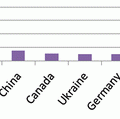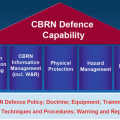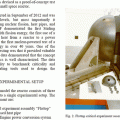French classification of radioactive waste and management solutions (existing or being considered)
Half-life
Very short-lived
Short-lived
Long lived
Activity level
<100 days
<30 years
>30 years
Very low-level waste (VLLW)
Waste managed by allowing the radioactivity to decay in situ
Aube VLL waste disposal facility (CIRES)
Low-level waste (LLW)
Aube LLW/ILW waste disposal facility (CSA)
Studies in progress (radium-bearing and graphite waste)
Intermediate-level waste (ILW)
Studies in progress (tritiated waste)
Studies in progress pursuant to the 1991 Act
High-level waste (HLW)
Studies in progress pursuant to the 1991 Act (CIGEO project)
The inventory published in 2012 gives existing quantities and those estimated for the coming years. It is presented in Table 7.2.
Table 7.2
Inventory published in 2012 (Source Andra)
2010 (m3 conditioned waste) | 2020 | 2030 | |
|---|---|---|---|
HLW | 2,700 | 4,000 | 5,300 |
ILW-LL | 40,000 | 45,000 | 49,000 |
LLW-LL | 87,000 | 89,000 | 133,000 |
LLW/ILW-SL | 830,000 | 1,000,000 | 1,200,000 |
VLLW | 360,000 | 762,000 | 1,300,000 |
Total | ∼1,320,000 | ∼1,900,000 | ∼2,700,000 |
The inventory is hence based on a wide-ranging dialogue between the waste producers, the public authorities and Andra, in order to define the volume of radioactive materials to be managed, according to the electrical energy production scenarios. The scenarios studied in France and on which the inventory forecasts are based, primarily concern the service life extension of the nuclear power plants from 40 to 50 years, the changes in the French nuclear power reactor fleet and the varying share of renewable energy sources in the country’s energy mix.
Whatever the scenario finally adopted, the existing and future quantities will represent considerable volumes which demand the full attention of the stakeholders in the field, in order to minimise the risk of misappropriation of these materials, even if only a few cubic metres, to organise acts of terror.
7.4 LLW/ILW-SL Waste
As it contains no fissile products, low and intermediate level, short-lived waste presents no risk in terms of nuclear proliferation. The danger that could arise from the recovery of this material by an ill-intentioned undertaking could primarily lie in the psychosis of terror created by the announced dissemination of material that is contaminated or which emits radiological radiation. The paralysis of the nation’s services and infrastructures could seriously destabilise a country and help bend it to the will of the perpetrators of these acts.
Stay updated, free articles. Join our Telegram channel

Full access? Get Clinical Tree






